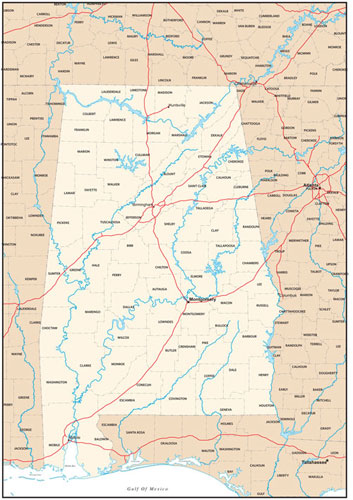Sign up for the Family Tree Newsletter Plus, you’ll receive our 10 Essential Genealogy Research Forms PDF as a special thank you!
Get Your Free Genealogy Forms
"*" indicates required fields
Alabama’s history is culturally diverse. Indians long inhabited the region and the Spanish explored there in the 16th century. France established the first permanent white settlement near Mobile Bay in 1702 as part of Louisiana. At the end of the French and Indian War (1763), France ceded to Britain lands east of the Mississippi River, including Alabama, as part of West Florida. However, Spain occupied coastal Alabama in 1780. At the end of the American Revolution, the 1783 Treaty of Paris gave the United States land north of the present Alabama-Florida boundary, the 31st parallel of latitude; Spain kept the Mobile Bay area as part of Spanish West Florida.
The US portion became part of Mississippi Territory in 1798, with most non-Indian residents living in Washington County. Although claimed by Georgia until 1802, the northern portion of the present state remained Indian lands. The Mobile Bay area was disputed territory after the Louisiana Purchase (1803), and US troops took the Spanish garrison at Mobile during the War of 1812. When Mississippi attained statehood in 1817, Alabama became a separate territory and two years later (1819) became the 22nd state.
Between 1805 and 1838, the US forced most Indians West and opened former Indian lands to white settlement. The land lured thousands of settlers, largely from Tennessee and Georgia, the Carolinas and Virginia. Numerous immigrants into central and southern Alabama used the Federal Road that stretched from Athens, Ga., to New Orleans.
Settlers found grasslands, forests and abundant wildlife, hills and plateaus in north and central counties, and coastal plains in the south. Agriculture, especially cotton and corn crops, dominated the economy until the 20th century.
Most of Alabama’s navigable rivers eventually empty into Mobile Bay or the Gulf of Mexico, but the Tennessee River dips across northern Alabama before heading north to the Ohio River. Early planters in northern counties shipped cotton to New Orleans via the Tennessee, Ohio, and Mississippi rivers; those in central and southern counties, used the port of Mobile for exporting crops and importing supplies. These factors and the lack of north-south roads kept the northern part of the state fairly isolated from central and southern Alabama and helped create regional and political differences. Many Alabama farmers, planters, and townspeople were slaveholders. By 1860, of Alabama’s nearly one million people, 55 percent were white and 45 percent were black, of whom less than 1 percent were free. Foreign-born people were about 1 percent. Ninety-five percent of the state’s population was rural. Not until 1960 did the state’s urban population surpass its rural population.
After Alabama seceded from the Union in January 1861, Montgomery was briefly the capital of the Confederate States of America. Confederate troops held Mobile almost until the end of the war, but the state saw about 200 engagements. Although most Alabamians supported the Confederate cause, a considerable number served in Union forces.
Left with widespread poverty after the war, Alabama didn’t experience significant recovery until the 1900s. By the mid-20th century, the state’s economy had diversified to include livestock, mining and steel, commercial forestry and related manufacturing, and production of consumer goods.
RESEARCH TIPS
- Until 1850, probate courts were called orphans courts.
- Some probate courts have packets of loose case papers; many older probate records have been microfilmed.
- Ancestors reportedly born in Mississippi before 1817 or West Florida before 1813 may have been born in what is now Alabama.
- Alabama’s federal censuses date from 1830.
- Much of Perry County’s 1890 census survives.
- Explore resources in the Alabama Department of Archives and History (http://www.archives.state.al.us), Birmingham Public Library, Samford University, and the University of Alabama.
CENSUS RECORDS
- Federal census population schedules: 1830, 1840, 1850, 1860, 1870, 1880, 1900, 1910, 1920, 1930
- State census: 1820, 1855, 1866
- Mississippi territorial census: 1810, 1816
- Federal mortality schedules for counties in existence: 1850, 1860, 1870, 1880
- Federal slave schedules: 1850, 1860 (schedules name slaveholders but rarely name slaves)
GENERAL RESOURCES
- Alabama Bible Records by Jeannette Holland Austin (J.H. Austin, 1987)
- Alabama: The History of a Deep South State by William Warren Rogers, et al. (University of Alabama Press, 1994)
- Alabama, Her History, Resources, War Record, and Public Men, from 1540 to 1872 by Willis Brewer (Clearfield Co., 1995)
- Alabama Research Outline by the Church of Jesus Christ of Latter-day Saints (online at http://www.familysearch.org/eng/search/RG/guide/alabama.asp)
- The Federal Road Through Georgia, the Creek Nation, and Alabama, 1806-1836 by Henry deLeon Southerland Jr. and Jerry Elijah Brown (University of Alabama Press, 1989)
- The Formative Period in Alabama, 1815-1828 by Thomas Perkins Abernethy (University of Alabama Press, 1990)
- History of Alabama and Dictionary of Alabama Biography, 4 vols., Thomas McAdory Owen (Reprint Co., 1978)
- Index to Colonel James Edmons Saunders’ Early Settlers of Alabama by Lloyd F. Oliver (Genealogical Publications, 1978)
- Indian Place Names in Alabama, revised edition, by William A. Read (University of Alabama Press, 1984)
- Notable Men of Alabama: Personal and Genealogical, with Portraits edited by Joel Campbell DuBose (Reprint Co., 1976)
- Place Names in Alabama by Virginia O. Foscue (University of Alabama Press, 1989)
- Some Early Alabama Churches (Established Before 1870) compiled by Mabel Ponder Wilson, Dorothy Youngblood Woodyerd, and Rosa Lee Busby (Alabama Society, Daughters of the American Revolution)
- Tracing Your Alabama Past by Robert Scott Davis (University Press of Mississippi, 2003)
Return to the main Alabama page
From the Family Tree Sourcebook
ADVERTISEMENT


